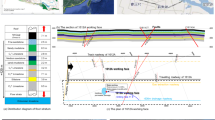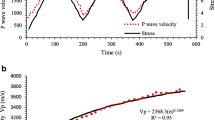Abstract
After a mine was flooded by water inrush, a suspected collapse column was speculated based on 3D seismic data, but was not found by drill holes. Seismic source positioning based on different signal arrival times was used to determine the position of the water-inrush point, permitting rapid and accurate grouting and mine restoration. The impact of the water on the roadway roof was used as a continuous and dynamic secondary seismic source, along with surface microseismic monitoring of microseismic events near the inrush collapse column, and two suspected inrush points were rapidly located, which provided the information needed for layout of surface directional detection boreholes. The drilling results indicated that one of the suspected inrush points was a collapse column; its positon had a planar error of 26 m compared to the collapse column controlled by drilling. The inrush point was located 77 m below the seam floor, and the size of the collapse column was 19 m × 7 m. Thus, microseismic monitoring holds promise for rapidly targeting grouting at similar sites.
Zusammenfassung
Nach der plötzlichen Flutung eines Bergwerks wurde anhand von Registrierungen der 3D-Seismik darauf geschlossen, dass der Wassereinbruch möglicherweise im Zusammenhang mit einer Einsturzbrekzie steht, welche durch Bohrungen nicht identifiziert werden konnte. Auf Grundlage unterschiedlicher Signalankunftszeiten wurde die Position einer seismischen Quelle untersucht, um die genaue Lokation des Wassereinbruchs zu bestimmen. Dieses Vorgehen sollte zu schnell umsetzbaren und zielgerichteten Bohrinjektionen führen, um den Betrieb des Bergwerks wieder zu ermöglichen. Der Aufprallsignale des Wassers auf die Fahrbahndecke wurden als kontinuierliche bzw. dynamische sekundäre seismische Quellen genutzt. Zusammen mit der mikroseismischen Oberflächenüberwachung konnten mikroseismische Ereignisse in der Nähe einer Einsturzbrekzie, welche für den Zufluss verantwortlich war, identifiziert werden. Zwei vermutete Zuflusslokationen wurden somit rasch identifiziert und waren Grundlage für das Abteufen von gerichteten Tagesbohrungen. Die Bohrergebnisse zeigten, dass einer der vermuteten Zuflusspunkte durch eine Einsturzbrekzie bedingt war; deren Position 26 m von der Stelle entfernt war, an der diese ursprünglich vermutet worden war. Der Zuflussbereich befand sich 77 m unterhalb der Flözsohle, die Größe der Einsturzbrekzie betrug 19 m × 7 m. Die mikroseismische Überwachung ist somit zielgerichtet nutzbar, um Bohrinjektionen in ähnlichen Fällen rasch und gezielt durchzuführen.
Resumen
Después de que una mina se inundara por irrupción de agua, se sospechó de la responsabilidad de una columna de colapso basándose en datos sísmicos 3D, pero la misma no fue encontrada por los agujeros de perforación. El posicionamiento de la fuente sísmica basado en diferentes tiempos de llegada de la señal se utilizó para determinar la posición del punto de irrupción de agua, permitiendo una rápida y precisa inyección de lechada para la restauración de la mina. El impacto del agua se utilizó como fuente sísmica secundaria continua y dinámica, junto con la vigilancia microsísmica de superficie de los eventos microsísmicos cerca de la columna de colapso de la irrupción, y se localizaron rápidamente dos puntos sospechosos de irrupción, lo que proporcionó la información necesaria para la disposición de las perforaciones de detección direccional. Los resultados de las perforaciones indicaron que uno de los puntos de irrupción sospechosos era una columna de colapso; su posición estaba a 26 m de distancia de donde se sospechaba originalmente que estaba la columna de colapso. El punto de irrupción estaba situado a 77 m por debajo del suelo de la veta, y el tamaño de la columna de colapso era de 19 m × 7 m. Por lo tanto, la vigilancia microsísmica es prometedora para detectar rápidamente la lechada en sitios similares.
抽象
煤矿突水之后, 依据三维地震推断可能存在一个未被钻孔揭露的陷落柱。利用信号到达时间差异的震源定位法识别突水点, 实现了快速、准确注浆和矿井恢复。视水对巷道顶板的影响为持续的动态次生震源,连同地面微震监测到的突水陷落柱附近微震事件,快速地定位了两个疑似突水点, 为地面定向勘探孔布设提供了依据。钻探揭露表明, 其中一个疑似突水点为陷落柱, 它距离最初的疑似陷落柱26米。突水点位于煤层底板以下77m, 陷落柱尺寸为19m × 7 m。微震监测有望用以类似情形的快速靶向注浆。








Similar content being viewed by others
References
Cheng JY, Zhao W, Cao DT (2010) Pondering on coalmine winning district 3D seismic correlation of prospecting and mining information effect analysis. Chin Coal Geol 22(8):67–73 (in Chinese)
Cheng JY, Jiang H, Ji GZ (2015) Channel wave seismic exploration technology based on node digital seismograph in an underground mine. Coal Sci Technol 43(2):25–28 (in Chinese)
Cong S, Cheng JY, Wang YH (2016) The development review of mining microseismic monitoring technology and its future outlook. Chin Min Mag 25(12):87–94 (in Chinese)
Dong SN (2010) Some key scientific problems on water hazards that frequently occur in China’s coal mines. J Chin Coal Soc 35(1):66–70 (in Chinese)
Jiang FX, Ye GX, Wang CW (2008) Application of high-precision microseismic monitoring technique to water inrush monitoring in coal mine. Chin J Rock Mech Eng 27(9):1932–1938 (in Chinese)
Jiao Y, Bai HB (2013) Mechanism of delayed groundwater inrush from covered karst cave in coal seam floor. J Chin Coal Soc 28(2):377–382 (in Chinese)
Li YF, Cheng JY, Xiong XJ (2011) 3D seismic forward modeling of collapse column and comparison. J Chin Coal Soc 36(3):456–460 (in Chinese)
Liu ZB, Jin DW (2013) Study on surrounding rock failure laws of mining lower group coal seam in north China coalfield. Coal Sci Technol 41(7):24–27, 31 (in Chinese
Liu ZB, Yang XG (2016) Method to distinguish water inrush channel in seam floor based on water quantity evolution features. Coal Sci Technol 44(6):152–158 (in Chinese)
Lu T, Liu SD, Wang B, Wu RX, Hu XW (2017) A review of geophysical exploration technology for mine water disaster in China: applications and trends. Mine Water Environ 36(3):331–340
Ning JH, Zhang GZ (2015) Seismic identification technique and its application of collapse column. Coal Geol Explor 33(3):64–67 (in Chinese)
Smith V, Jaques P (2015) Illinois Basin – Decatur Project pre-injection microseismic analysis. Int J Greenh Gas Con 54(1):362–377
Sun WJ, Zhou WF, Jiao J (2016) Hydrogeological classification and water inrush accidents in China’s coal mines. Mine Water Environ 35(2):214–220
Wang YH (2016) Grid-search method on micro-seismic source fast location based on DIRECT algorithm. Progr Geophys 31(4):1700–1708 (in Chinese)
Yin SX (2009) Modes and mechanism for water inrushes from coal seam floor. J Xi’an U Sci Tech 29(6):661–665 (in Chinese)
Yin SX, Wu Q, Wang SX (2004) Studies on characters and forming mechanism of karstic collapse columns at mine area of north China. Chin J Rock Mech Eng 23(1):120–123 (in Chinese)
Yin SX, Wu Q, Wang SX (2005) Water-bearing characteristics and hydro-geological models of karstic collapse columns in north china. Chin J Rock Mech Eng 24(1):77–83 (in Chinese)
Zhao QB (2014) Ordovician limestone karst water disaster regional advanced governance technology study and application. J Chin Coal Soc 39(6):1112–1117 (in Chinese)
Zhao QB, Cheng JY, Du BS (2008) The Comprehensive technology for subsidence column prospecting applied in the Dongpang coalmine. Coal Sci Technol 36(8):96–100 (in Chinese)
Zhao QB, Zhao XN, Wu Q (2015) Water burst mechanism of “divided period and section burst” at deep coal seam floor in north China type coalfield mining area. J Chin Coal Soc 40(7):1601–1607 (in Chinese)
Author information
Authors and Affiliations
Corresponding author
Rights and permissions
About this article
Cite this article
Cheng, J., Wang, P., Nan, S. et al. Rapidly Locating a Water–inrush Collapse Column in a Seam Floor: A Case Study. Mine Water Environ 40, 389–397 (2021). https://doi.org/10.1007/s10230-021-00768-0
Received:
Accepted:
Published:
Issue Date:
DOI: https://doi.org/10.1007/s10230-021-00768-0




